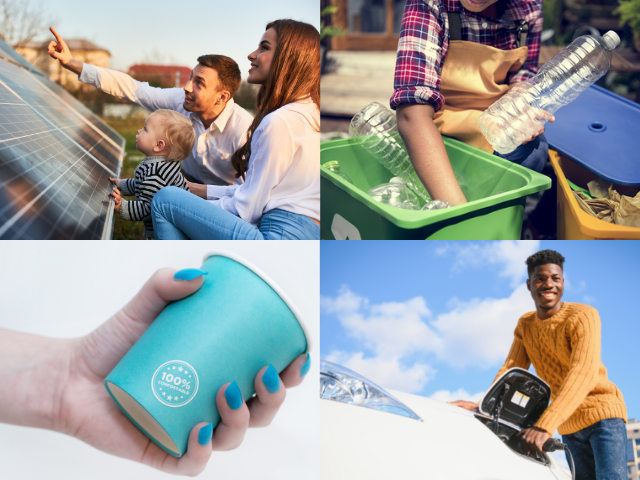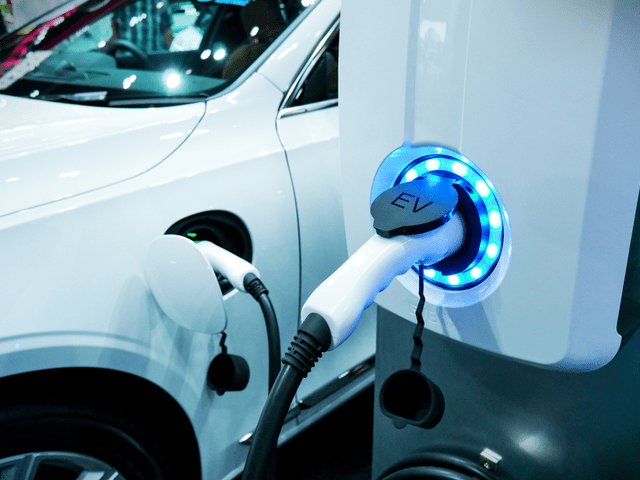- Industrial
- Aerospace
- Assembly
- Automotive
- Building & Construction
- Flexible Packaging
- General Transportation
- Rigid Packaging
- Tape & Label
May 6, 2022 - 10 min
Are You Prepared to Meet 2030 Sustainability Goals?

While many manufacturing companies across markets have sustainability goals, these goals can often get deprioritized when trying to address pressing, immediate issues, such as supply chain disruptions and rising costs. However, sustainability is slated to become an increasingly top demand from OEMs and brand owners in years to come, due to governmental initiatives and consumer pressures.
In fact, The Federal Sustainability Plan outlines a number of goals to cut U.S. greenhouse gas emissions in half by 2030. Some of these goals include:
- 100% Carbon Pollution-Free Electricity by 2030, including 50% on a 24/7 basis
- Net-Zero Emissions Operations by 2050, including a 65% reduction by 2030
- Develop a Climate- and Sustainability-Focused Workforce
- Accelerate Progress through Domestic and International Partnerships
- Climate Resilient Infrastructure and Operations
Further, the United Nations has developed the Paris Agreement, an international treaty on climate change. The overall goal aligns with the U.S. Federal Sustainability Plan to limit global warming to 1.5 degrees Celsius compared to pre-industrial levels. This means countries must co-executively reduce their greenhouse gas emissions as soon as possible to reach climate neutrality worldwide. Therefore, manufacturers need to do what they can now to ensure they are ready and able to provide their customers with the sustainable products they will soon demand, if not doing so already.
One way to address sustainability pressures and be on the path to achieving the goals for 2030 is by choosing sustainable adhesives and sealants. This is because products and manufacturing processes both heavily rely on adhesives and sealants, and they play an important role in a company’s ability to address sustainability demands. For example, at least eight components in the makeup of an electric vehicle are comprised of adhesive bonds, including battery cells, packs, enclosures, controllers and sensors.
Find out the value sustainable bonding and sealing can offer to your products and manufacturing processes, helping your company meet key governmental initiatives and global quality of life goals by 2030.
How Adhesives and Sealants Help You Address Key Governmental Initiatives
In upcoming years, it will become imperative for manufacturers to produce products that meet the following governmental sustainability initiatives:
Facility Waste Production
Right now, there is push for manufacturers to reevaluate how both their products and processes affect the environment in preparation to achieve the 2030 goals. Currently, 80% of manufactured products are thrown away within the first six months of their life. This is in part due to the types of materials manufacturing companies choose and whether a consumer can recycle or compost them at their end of life. This waste has a massive impact on rising landfills across the U.S. In 2018, around 146.2 million tons of municipal solid waste went to landfills, according to the EPA. In the same year, municipal solid waste landfills were recorded as the third largest contributor to U.S. human-related methane emissions, equivalent to 20.6 million passenger vehicles driven for a year.
Under the initiative to develop a climate and sustainability-focused workforce, there is push to make sustainability a priority amongst both federal agencies and private companies through their staffing, training and resources to reduce waste production. Companies are encouraged to make sustainability a priority, so employees find ways to make products more environmentally friendly for the end user and product’s end of life.
Energy Usage Reduction
While processes vary amongst manufacturers, facilities use an average of 95.1 kilowatt-hours (kWh) of electricty and 536,500 Btu of natural gas per square foot each year. The U.S. government is also aiming for 100 percent carbon pollution-free electricity by 2030, including 50 percent of it to be on a 24/7 basis. This means manufacturers will need to reassess how they utilize their energy consumption for petroleum and coal, chemicals, paper, metals and food. This means evaluating their heating, drive power, cogeneration and boilers, as they consume the most energy in manufacturing facilities.
Carbon Emissions Reduction
About 23 percent of U.S. greenhouse gas emissions result directly from manufacturing, food processes, construction and mining. It stems from efforts to find fossil fuels for heat and power and chemical processes for iron, steel and cement. These greenhouse gas emissions cause the earth’s surface temperature to rise. Therefore, the U.S. government is pushing a net-zero emissions operations by 2050, which includes a 65% reduction by 2030. This effort includes transitioning to zero-emission vehicles and buildings, powering facilities with carbon pollution-free electricity. Additionally, the government plans to partner with public and private companies to do so.
Fortunately, adhesives and sealants can help address these initiatives, offering:
Decreased Waste Production: Adhesives and sealants can provide new methods for manufacturing plants that help mitigate waste production and environmental impact. For example, water-based, cold seal adhesives are designed for both film and paper confectionary food packaging production lines. Because they are water-based, they enable better recyclability than other options due to easy wash-off capabilities during repulp processes. Further, they don’t bleed through the materials, which means additional backing is not needed, and material usage is further reduced. Compostable adhesives also help reduce waste production. This is especially helpful for food packaging, which typically gets contaminated with food and ends up in a landfill. When used with other compostable materials, compostable adhesives ensure a package decomposes fully outside a landfill, minimizing harmful greenhouse gases.
Reduced Energy Usage: Adhesives and sealants can also reduce facility energy usage, specifically when manufacturers take advantage of smart processes. Many types are formulated for lower application temperatures, meaning equipment settings don’t have to be as high as other options, which uses up more electricity. For example, often, facilities continually heat hot melt adhesives just above a softening point to reduce charring, but this approach can increase energy usage. A drum unloader, however, can be directly connected to the line, making a holding tank optional. This allows the hot melt to soften and melt as it’s needed, lessening chances of charring while decreasing energy usage and overall production costs. Other types, such as water-based, don’t always need equipment to dry it because the water evaporates, forming the bond. Specifically for interior automotive manufacturing, water-based adhesives enable accurate curing and do not require dry atomization before application. This helps manufacturers reduce steps and error likelihood while also extending pot life.
Reduced Carbon Emissions: Adhesives and sealants also help reduce carbon emissions overall. For example, they enable other lightweight materials to be used in product design, such as composites. Compared to other options, these lightweight materials enable improved fuel efficiency, which reduces greenhouse gas emissions in the final product. Additionally, adhesives are becoming a critical component to EV batteries. They enable vehicle weight reduction, which helps increase the battery range and lower the vehicle’s overall carbon emissions while in use. As EV production increases, the EV battery range is predicted to reach 400 miles by 2028. Linerless labels are another example of how adhesives can offer lightweight solutions that improve overall fuel efficiencies. Without the release liner (which also reduces waste), more linerless labels can fit on to a roll and in a shipping package, allowing for more product shipping in fewer transports.

How Adhesives and Sealants Help You Address the United Nations’ Climate Change Goals
Paris Agreement’s overall goal is to reduce global warming levels. Similar to the U.S. Federal Sustainability Plan, this involves reducing carbon emissions in every country. Adhesives and sealants can support this agreement, possessing:
Low volatile organic compounds (VOCs): Specifically for the construction market, adhesives and sealants can ensure VOC emissions are minimal in residential and commercial buildings. They can help reduce emissions with solid wood or wheatboard in doors or trims as well as ceramic tike, slate hardwood, true linoleum or colored concrete in flooring. Additionally, there is an International Green Construction Code to lessen VOCs in low-slope roof coatings to less than 50 grams per liter. Butyl adhesives can assist in meeting this requirement, because they have zero to low chemical emissions while retaining weather-resistant adhesion in roofing.
Solvent-free solutions: Adhesives and sealants are deemed solvent-free if they contain 5% or less solvent in their formulations. Solvent-free solutions reduce health risks and improve carbon footprint while offering manufacturers flexible processing time and high initial strength. This is especially important for food or medical packaging, construction and general transportation manufacturing, which all directly affect humans or wildlife. Two types of solvent-free adhesives in particular are growing rapidly in the market:
- Water-based adhesives typically have higher surface energies than solvent-based adhesives and can improve overall application performance.
- Hot melt adhesives are a versatile solution across markets and can be compostable, aiding in an entire package being able to break down into non-toxic, natural elements.
How Bostik Can Help You Become a Sustainability Enabler
In addition to addressing these key governmental initiatives and quality of life goals, Bostik helps customers accelerate their responsible practices to better address governmental initiatives and climate change goals. As an Arkema company, we are committed to finding solutions that improve health and safety, reduce environmental footprint and follow ethics and compliance. We offer products that are formulated to:
- Increase sustainability levels from beginning to end of life: Bostik is continually developing formulations composed of bio-based or recycled materials. We make sure our solutions help your production methods become more energy efficient. We also are reducing our raw material usage and energy consumption and investing in low carbon and renewable energy sources.
- Improve product longevity: In addition to being sustainably sourced, these solutions provide strong bonding and sealing to protect from potentially harmful chemicals, weathering or temperatures. This will ensure your application performance will remain durable for the long term.
We also contribute to the Paris Climate Agreement’s sustainable development goals. Many of our products have low VOCs and are solvent and isocyanate free to increase clean energy. This includes a range of water-based and hot melt adhesive products.
Interested in learning more about how Bostik can help your company achieve sustainability goals by 2030? Contact a Bostik representative today to learn more.
Learn more about our social responsibility to become sustainable enablers:
Join the Movement of Sustainability Enablers
